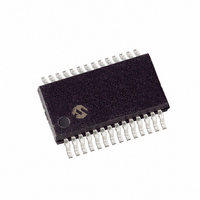PIC18F24K20-I/SS Microchip Technology, PIC18F24K20-I/SS Datasheet - Page 40

PIC18F24K20-I/SS
Manufacturer Part Number
PIC18F24K20-I/SS
Description
IC PIC MCU FLASH 8KX16 28SSOP
Manufacturer
Microchip Technology
Series
PIC® XLP™ 18Fr
Datasheets
1.PIC18F25K20T-ISS.pdf
(42 pages)
2.PIC18F25K20T-ISS.pdf
(12 pages)
3.PIC18F25K20T-ISS.pdf
(14 pages)
4.PIC18F25K20T-ISS.pdf
(456 pages)
5.PIC18F26K20-ISO.pdf
(430 pages)
Specifications of PIC18F24K20-I/SS
Program Memory Type
FLASH
Program Memory Size
16KB (8K x 16)
Package / Case
28-SSOP
Core Processor
PIC
Core Size
8-Bit
Speed
64MHz
Connectivity
I²C, SPI, UART/USART
Peripherals
Brown-out Detect/Reset, HLVD, POR, PWM, WDT
Number Of I /o
24
Eeprom Size
256 x 8
Ram Size
768 x 8
Voltage - Supply (vcc/vdd)
1.8 V ~ 3.6 V
Data Converters
A/D 11x10b
Oscillator Type
Internal
Operating Temperature
-40°C ~ 85°C
Processor Series
PIC18F
Core
PIC
Data Bus Width
8 bit
Data Ram Size
768 B
Interface Type
CCP/ECCP/EUSART/I2C/MSSP/SPI
Maximum Clock Frequency
64 MHz
Number Of Programmable I/os
25
Number Of Timers
4
Operating Supply Voltage
3 V
Maximum Operating Temperature
+ 85 C
Mounting Style
SMD/SMT
3rd Party Development Tools
52715-96, 52716-328, 52717-734, 52712-325, EWPIC18
Development Tools By Supplier
PG164130, DV164035, DV244005, DV164005, PG164120, DV164136
Minimum Operating Temperature
- 40 C
On-chip Adc
11-ch x 10-bit
Package
28SSOP
Device Core
PIC
Family Name
PIC18
Maximum Speed
64 MHz
Lead Free Status / RoHS Status
Lead free / RoHS Compliant
Lead Free Status / RoHS Status
Lead free / RoHS Compliant, Lead free / RoHS Compliant
Available stocks
Company
Part Number
Manufacturer
Quantity
Price
Part Number:
PIC18F24K20-I/SS
Manufacturer:
MICROCHIP/微芯
Quantity:
20 000
- PIC18F25K20T-ISS PDF datasheet
- PIC18F25K20T-ISS PDF datasheet #2
- PIC18F25K20T-ISS PDF datasheet #3
- PIC18F25K20T-ISS PDF datasheet #4
- PIC18F26K20-ISO PDF datasheet #5
- Current page: 40 of 456
- Download datasheet (4Mb)
PIC18F2XK20/4XK20
2.11
The Fail-Safe Clock Monitor (FSCM) allows the device
to continue operating should the external oscillator fail.
The FSCM can detect oscillator failure any time after
the Oscillator Start-up Timer (OST) has expired. The
FSCM is enabled by setting the FCMEN bit in the
CONFIG1H Configuration register. The FSCM is
applicable to all external oscillator modes (LP, XT, HS,
EC, RC and RCIO).
FIGURE 2-8:
2.11.1
The FSCM module detects a failed oscillator by
comparing the external oscillator to the FSCM sample
clock. The sample clock is generated by dividing the
LFINTOSC by 64. See Figure 2-8. Inside the fail
detector block is a latch. The external clock sets the
latch on each falling edge of the external clock. The
sample clock clears the latch on each rising edge of the
sample clock. A failure is detected when an entire half-
cycle of the sample clock elapses before the primary
clock goes low.
2.11.2
When the external clock fails, the FSCM switches the
device clock to an internal clock source and sets the bit
flag OSCFIF of the PIR2 register. The OSCFIF flag will
generate an interrupt if the OSCFIE bit of the PIE2
register is also set. The device firmware can then take
steps to mitigate the problems that may arise from a
failed clock. The system clock will continue to be
sourced from the internal clock source until the device
firmware successfully restarts the external oscillator
and switches back to external operation. An automatic
transition back to the failed clock source will not occur.
The internal clock source chosen by the FSCM is
determined by the IRCF<2:0> bits of the OSCCON
register. This allows the internal oscillator to be
configured before a failure occurs.
DS41303G-page 40
LFINTOSC
Oscillator
(~32 s)
External
31 kHz
Clock
Sample Clock
Fail-Safe Clock Monitor
FAIL-SAFE DETECTION
FAIL-SAFE OPERATION
(~2 ms)
488 Hz
÷ 64
FSCM BLOCK DIAGRAM
Clock Monitor
R
S
Latch
Q
Q
Detected
Failure
Clock
2.11.3
The Fail-Safe condition is cleared by either one of the
following:
• Any Reset
• By toggling the SCS1 bit of the OSCCON register
Both of these conditions restart the OST. While the
OST is running, the device continues to operate from
the INTOSC selected in OSCCON. When the OST
times out, the Fail-Safe condition is cleared and the
device automatically switches over to the external clock
source. The Fail-Safe condition need not be cleared
before the OSCFIF flag is cleared.
2.11.4
The FSCM is designed to detect an oscillator failure
after the Oscillator Start-up Timer (OST) has expired.
The OST is used after waking up from Sleep and after
any type of Reset. The OST is not used with the EC or
RC Clock modes so that the FSCM will be active as
soon as the Reset or wake-up has completed. When
the FSCM is enabled, the Two-Speed Start-up is also
enabled. Therefore, the device will always be executing
code while the OST is operating.
Note:
FAIL-SAFE CONDITION CLEARING
RESET OR WAKE-UP FROM SLEEP
Due to the wide range of oscillator start-up
times, the Fail-Safe circuit is not active
during oscillator start-up (i.e., after exiting
Reset or Sleep). After an appropriate
amount of time, the user should check the
OSTS bit of the OSCCON register to verify
the oscillator start-up and that the system
clock
completed.
switchover
2010 Microchip Technology Inc.
has
successfully
Related parts for PIC18F24K20-I/SS
Image
Part Number
Description
Manufacturer
Datasheet
Request
R

Part Number:
Description:
Manufacturer:
Microchip Technology Inc.
Datasheet:

Part Number:
Description:
Manufacturer:
Microchip Technology Inc.
Datasheet:

Part Number:
Description:
Manufacturer:
Microchip Technology Inc.
Datasheet:

Part Number:
Description:
Manufacturer:
Microchip Technology Inc.
Datasheet:

Part Number:
Description:
Manufacturer:
Microchip Technology Inc.
Datasheet:

Part Number:
Description:
Manufacturer:
Microchip Technology Inc.
Datasheet:

Part Number:
Description:
Manufacturer:
Microchip Technology Inc.
Datasheet:

Part Number:
Description:
Manufacturer:
Microchip Technology Inc.
Datasheet:











